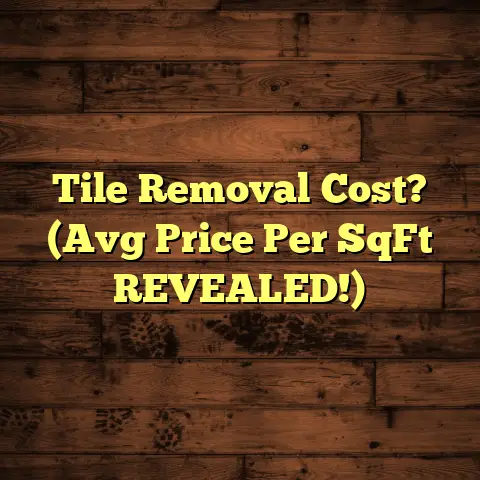Laminate Floors Meeting? (1 Tiny Gap = Disaster!)
Have you ever noticed a tiny gap in your laminate flooring and thought, “Eh, it’s nothing”? Let me tell you, as a flooring contractor with over 20 years in the game, I’ve seen those “nothing” gaps turn into nightmares that cost homeowners thousands.
I remember Mrs. Davison, a sweet lady who decided to DIY her living room with laminate. She was so proud of her work, until a few months later. A small gap near the patio door let in moisture from a rainstorm.
Within weeks, her floor was buckling, and mold was creeping under the surface. What started as a tiny gap ended up costing her over $5,000 in repairs and a whole lot of stress. That’s why I’m here to tell you: that tiny gap is a disaster waiting to happen!
Section 1: Understanding Laminate Flooring
So, what exactly is laminate flooring? It’s not solid wood, that’s for sure. Think of it like a multi-layered sandwich. You’ve got a high-density fiberboard (HDF) core, a decorative photographic layer that looks like wood (or tile, or stone!), and a tough, transparent wear layer on top.
Here’s a breakdown:
| Layer | Function |
|---|---|
| Wear Layer | Protects against scratches & wear |
| Decorative Layer | Provides the visual appeal |
| HDF Core | Provides stability & impact resistance |
| Backing Layer | Protects against moisture from below |
Laminate has exploded in popularity because it’s affordable, looks great, and is relatively easy to install. Home Depot reports that laminate flooring sales have consistently increased by 5-7% annually over the last decade, showing its strong appeal.
The genius of laminate lies in its interlocking system. Each plank has tongue-and-groove edges that snap together. When installed correctly, these edges create a tight seal, preventing moisture from seeping in. But, and this is a big but, if those edges aren’t perfectly aligned, you’re asking for trouble.
Section 2: The Importance of Proper Installation
Now, let’s talk installation. You might think, “Hey, I can handle this myself!” And you might be right. But trust me, proper installation is everything with laminate.
Here’s a simplified overview:
- Prep the Subfloor: It needs to be level, clean, and dry. Any imperfections will telegraph through the laminate.
- Underlayment: This provides cushioning, sound insulation, and a moisture barrier. Don’t skip it!
- Acclimation: Let the laminate sit in the room for 48-72 hours before installing. This allows it to adjust to the temperature and humidity, minimizing expansion and contraction later on.
- Precise Cuts: Use a sharp saw and measure carefully. Gaps often occur due to sloppy cuts.
- Proper Locking: Ensure each plank clicks securely into place. Don’t force it! If it doesn’t fit easily, something is wrong.
- Expansion Gap: Leave a small gap (usually ¼ inch) around the perimeter of the room. This allows the floor to expand and contract without buckling.
One of the biggest pitfalls I see is rushing the job. People get impatient, skip steps, and end up with gaps. I remember one client, a young guy named Mark, who was so eager to finish his basement that he didn’t properly acclimate the flooring. Within a few weeks, his floor was bulging in the middle of the room. A costly mistake!
As Bob Vila, the home improvement guru, always says, “Measure twice, cut once.” This couldn’t be truer when it comes to laminate flooring.
Section 3: What Happens When Gaps Appear?
Okay, so you’ve got a gap. What’s the big deal? Well, let me paint you a picture.
Gaps are like open invitations for moisture. Water, spills, even humidity can seep beneath the surface, where it can wreak havoc.
Here’s what can happen:
- Warping: The HDF core absorbs moisture and swells, causing the planks to warp and become uneven.
- Buckling: As the planks expand, they push against each other, causing them to buckle and lift.
- Mold Growth: Damp, dark environments are perfect breeding grounds for mold. This can lead to health problems and a nasty smell.
- Delamination: The layers of the laminate can separate, ruining the appearance of the floor.
According to the Institute of Inspection, Cleaning and Restoration Certification (IICRC), mold growth can begin within 24-48 hours of water exposure. That’s how quickly things can go south!
I’ve seen homes where entire laminate floors had to be replaced due to moisture damage from a single, neglected gap. It’s not pretty, and it’s certainly not cheap.
Section 4: The Ripple Effect of a Tiny Gap
Think of a tiny gap as the first domino in a long line. It might seem insignificant at first, but it can trigger a chain reaction of problems that spread throughout your entire flooring system.
Let’s say you have a small gap near your kitchen sink. Every time you wash dishes, a little water splashes onto the floor and seeps into the gap. Over time, this moisture weakens the surrounding planks, causing them to warp and separate.
As the warping spreads, it puts stress on the adjacent planks, causing them to develop gaps. Before you know it, you have a whole section of flooring that’s compromised.
This “domino effect” can extend beyond the flooring itself. Moisture can seep into the subfloor, damaging it and potentially leading to structural problems. Mold growth can spread to the walls and even the air ducts, contaminating your entire home.
I had a client, Mr. Henderson, who ignored a small gap in his bathroom floor for months. He figured it was just a cosmetic issue. Eventually, the moisture damage spread to the wall behind the toilet, causing the drywall to crumble and requiring extensive repairs.
The moral of the story? Don’t underestimate the power of a tiny gap. Address it immediately before it turns into a full-blown disaster.
Section 5: Prevention is Key
When it comes to laminate flooring, an ounce of prevention is worth a pound of cure. Being proactive during the flooring process can save you a lot of headaches and money down the road.
Awareness and education are your best weapons. The more you know about the potential pitfalls of laminate flooring, the better equipped you’ll be to avoid them.
Quality materials also play a crucial role. Cheaper laminate products often have weaker locking systems and are more susceptible to moisture damage. Investing in a higher-quality product can significantly reduce the risk of gaps and other issues.
Professional installation is another key factor. While DIY installation can save you money upfront, it’s often a false economy. Experienced installers have the knowledge, skills, and tools to ensure that your laminate floor is installed correctly and that any potential problems are addressed before they become major issues.
Section 6: The Psychological Impact on Homeowners
Your home is your sanctuary, your safe haven. It’s where you relax, spend time with loved ones, and create lasting memories. When something goes wrong with your home, it can have a significant impact on your mental and emotional well-being.
Flooring issues, even seemingly minor ones like gaps, can be a constant source of anxiety and stress. Every time you see that gap, you’re reminded of the potential problems it could cause. You might worry about water damage, mold growth, or the cost of repairs.
I’ve seen homeowners who were so stressed out by their flooring problems that they couldn’t sleep at night. They felt like their homes were incomplete, compromised, and no longer a source of comfort.
Remember Mrs. Davison from the beginning of the article? She told me that the buckling laminate floor made her feel like her whole house was falling apart. It affected her mood, her energy levels, and her overall sense of well-being.
That’s why it’s so important to address flooring issues promptly and effectively. Not only will it protect your investment, but it will also protect your peace of mind.
Section 7: The Future of Laminate Flooring
The laminate flooring industry is constantly evolving, with new technologies and designs emerging all the time. One of the biggest trends is the development of more water-resistant and waterproof laminate products.
These new products feature tighter locking systems and enhanced moisture barriers, making them less susceptible to water damage from spills and leaks. Some manufacturers are even using waterproof core materials, such as polymer composites, to create truly waterproof laminate floors.
Another trend is the increasing popularity of wide-plank laminate flooring. Wide planks create a more modern and spacious look, but they also require more precise installation to prevent gaps.
Consumers are also demanding more sustainable and eco-friendly flooring options. Manufacturers are responding by using recycled materials and developing more environmentally friendly manufacturing processes.
As consumer demand for quality and sustainability continues to grow, the laminate flooring industry will continue to innovate and improve its products. The future of laminate flooring looks bright, with new technologies and designs promising to make it even more durable, beautiful, and eco-friendly.
Conclusion:
So, there you have it. A tiny gap in your laminate flooring might seem like no big deal, but it can quickly turn into a costly and stressful disaster. From moisture damage and mold growth to warped planks and structural problems, the consequences of neglecting a gap can be severe.
Remember, vigilance and thoroughness are key. Inspect your laminate floor regularly for any signs of gaps or damage. Address any issues promptly and effectively. And if you’re not comfortable doing it yourself, don’t hesitate to call in a professional.
Your floor is the foundation of your home. Protect it, and it will protect you. Don’t let a tiny gap ruin your investment and your peace of mind. Take action today to ensure a beautiful, lasting, and gap-free floor for years to come.





